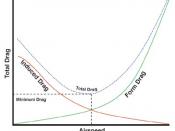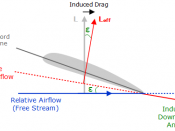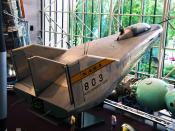AEROPLANE PHYSICS
[THIS PAPER WILL ADDRESS THE PHYSICS INVOLVED IN KEEPING AN AEROPLANE LEVEL DURING FLIGHT]
For centuries it has been mans dream to fly. Only in the last hundred years or so has this dream actually been realised. We are now able to fly using several different means. For example, there are hot air balloons, which are able to fly, or 'float', due to the lighter than air gas that they contain. Aeroplanes however, are too heavy to 'float' in the air. They have wings, providing a force called lift that holds them up.
Lift is the part of the total reaction at right angles to the relative airflow. It is varying according to the shape (camber) of the wings. Production of lift is dependant on two principles:
* Bernoulli's Principle and,
* Newton's Third Law of Motion.
Bernoulli's Principle
This principle, named after the Swiss mathematician and physicist Daniel Bernoulli (1700-82), states that the pressure in a moving fluid becomes less as the speed rises.
This effect causes the lift on an aircraft wing (aerofoil).
Other related features are:
* The total energy in a streamline flow remains constant
* Kinetic energy (Ek) + Potential energy (Ep) = constant
The Bernoulli principle can be demonstrated in this diagram of an instrument called a,
Venturi Tube
FLUID
FLOW
LOW SPEED FLOW HIGH SPEED FLOW
(HIGH PRESSURE) (LOW PRESSURE)
Application to Bernoulli's Principle on an Aerofoil
Due to the shape of an aerofoil, the air flowing over the wing travels further than air flowing under the wing, hence, it travels faster than the air underneath.
RESSULTANT UPWARD FORCE
(LIFT)
AREA OF LOW PRESSURE
(HIGH VELOCITY)
AREA OF HIGH PRESSURE
(LOW VELOCITY)
The high pressure area on the underside of the aerofoil and the low pressure area above provide the...


